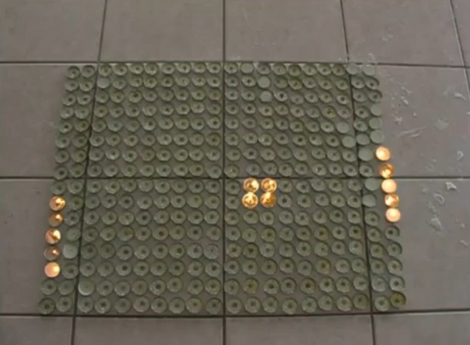
[Ollie] tipped us off about a stop motion video that uses a grid of tea candles to animate some classically pixellated game graphics. The image above is obviously a game of pong in progress. It’s interesting to watch but for us the fun is trying to decide how it’s done. Click through the break to see the video and discuss the methodology.
[youtube=http://www.youtube.com/watch?v=EG127HdhWZQ]
Perhaps the most obvious method used here is plain old stop motion animation. You light the candles, take a picture, snuff the ones you don’t need and light new ones, and repeat. There’s also the thought that the creator let the video roll, walked through his planned frames, then edited out the filler video after the fact.
To us, one thing is missing. Whenever we put out a tea candle that’s been burning for some time it tends to let off a rather vigorous column of smoke. We don’t see that in the video. Our thought is that you take a picture of all the candles before they’re lit. You then take several shots of all the candles lit. The multiple shots are so that the video shows flickering flames. From there an image processing program can be used along with a layer mask to digitally stuff the candles that you don’t need for each frame. Below is our attempt at this using The Gimp. But we want to know how you would have done it so leave us a comment.
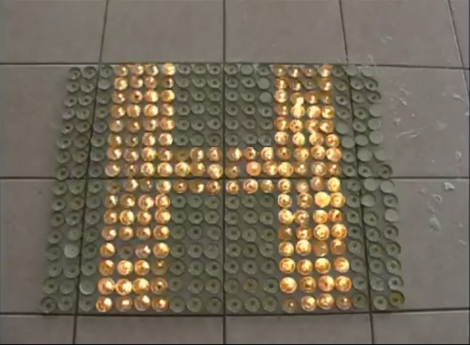
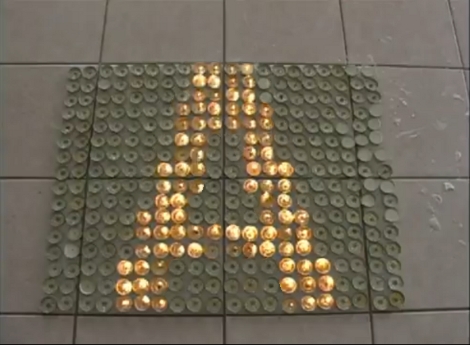
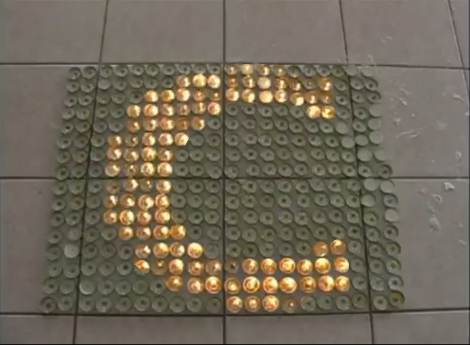
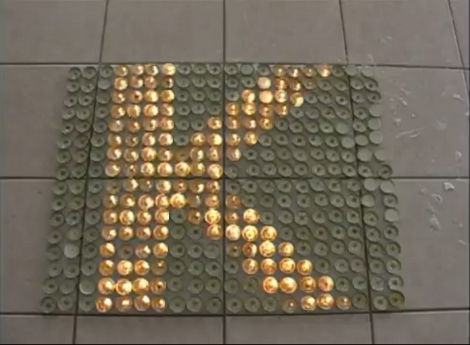
[via College Humor]















Cool and all, but far from any kind of a hack.
Very inventive. A nice departure from the customary hacks.
I can see a dead pixel!
On the second thought, are all the other pixels hot?
@Ozyg u see a cool pixel
looks like he could just light them and blow them out depending on weather frame needed new pixels added or old ones removed… seams easy but time consuming
The individual candle flames are clearly repeating – I think your theory is spot on.
Fantastic job either way!
fucking candles… how do they work?
i think it must have been done gigitally. there is a line of four candles on the right hand side that never seem to burn lower, despite being “lit” a few times. this suggests to me that it wasn’t done by lighting each candle for each frame it’s needed and snuffed when it’s not.
Projector above, then do anything you want with a blank grid and orange/yellow dots filling the grid in.
i noticed the wicks and wax never seem to change, nor does he ever nudge a candle or the camera between frames
i think it’s a loop of only so many frames that are masked
i bet it’s done with after effects
By the time the second image is taken, smoke from extinguished candles would have dissipated. With stop motion, each frame would be a separate photograph – very time consuming. Nice result though.
It’s possible it could be ‘hacked’ in photo editing software, but that might actually end up being more work!
Lovely idea. If you keep an eye on an individual candle, you can see its the same image sequence that comes up again and again so its obviously a masking effect of some sort.
@Jim: Agreed.
If you look at one of the bottom candles, you can tell it is in a loop. It does exactly the same thing over and over again.
Clever though :)
COME ON GUYS!
the video poster is the illusion master XD
yes its fake XD
he records all candles burning for say 5 secs, then all off. all you have to do after that is quadrant the individual candles into pixels, choose the on/off state needed, then stitch it back together and render it.
i dont know of a utility that could be scripted to do that off hand, but im sure one exists.
Film each candle individually, then make each clip a pixel. As long as the camera doesn’t move, just pick the pixels (candles) you want and overlay the video clips on top of each other.
Now this is a hack that could use propane with a cpu controlled valve running each flame . Then shoot in real time..
No candles lit: take a frame.
Light all candles: take a few frames.
Loop the frames with the candles lit, superimpose the unlit candles.
He probably took 2*(20*16)+1 picture.
2 per lit candle with every other unlit.
1 with all candles unlit
2 per candle alloy (in pixel) candle motion
Stack alternatively the right frames, say with matlab…. voila!
http://knowyourmeme.com/i/24183/original/500pxShopped.jpg
Since this is Hackaday… I’m going to definitely say it’s an Arduino controlled Rubens board.
Let Dennis Openheim teach you how it is done!
http://www.dennis-oppenheim.com/works/189
The individual flames loop quite fast, so it doesn’t look very real.
But if you filmed each individual candle for a minute, and composed the individual flames using a maximum brightness operation, it would look better.
Now I want to make an XY frame with a flamethrower and a damper to automate this on the web :)
Analog FTW.
you got too much time on your hand… lol
nice job… wow!
Who cares if it’s “shopped”, it is clever, entertaining and original. Seems like a far more efficient use of time than lighting or extinguishing each candle for every frame.
I would take a picture of all candles dim, another picture of all candles lit, code a program that generates the proper combined images from the appropriately sized low resolution monochrome “pixels” input and the 2 pictures mentioned, and finally make a video out of it all.
And thats probably what they did here. Note that the light from one candle “pixel” is supposed to “leak” a bit to the adjutant ones, illuminating them to some extent. Yet, in this video, it doesn’t seems to happen. Kinda hints the images are programatically generated.
Sorry, since the “pixels” on the final video do look like they move a bit, instead of 2 pictures i mentioned in the previous post, there should be 2 videos.
It’s still garden-variety stop-motion.
He just took multiple shots of each setting state, (a “state” being a certain X candles lit and the other 256-X candles not lit.) Try it youself: Take 12 shots of the same state and loop ’em over and over. Looks like real candle flicker.
So the fourth candle from the bottom in the second column is sort of an extremely low-tech dead pixel?
@nubie: now that’s an idea !
Please use a punch /Hollerith/IBM card system to “program” it.
Not only is there no smoke, and not only do the candles manage to burn at a constant and identical level every time they’re lit, but the ambient light in the room is coming from a window across the room. This stop motion animation would have taken HOURS to produce, and there is no way the light in the room would have stayed absolutely even the whole time. And there would have been some kind of change in the area around the candles. It looks like there’s a little wax on the floor to the right, but that wax never changes.
Nope, I’m going with your theory faked stop motion animation.
Even so, it’s a clever solution. You end up programming virtual pixels in the form of a large number of images. This same principle could be used with anything. Pretty cool!
Wow, if this were any other site there would have been tears shed over the possibility of a fake. Not applause at its ingenuity. This is why I like you guys.
Dont you only really need one candle to do this, if it is all just image tricks? Maybe 16 candles max to make any sized display :P
yep, light all candles, take a photo. blow them all out, take another photo. Then just use the masking effect.
@ neil
Candles are complicated.
Faraday’s lecture on the chemical history of the candle:
http://www.fordham.edu/halsall/mod/1860faraday-candle.html
Khordas
Is it working progressive or interlaced?
I’m kinda surprised that nobody’s written a Python script to use this as a custom display yet. Seems like creating a set of masks and using Python’s image manipulation capabilities would make for an easy animated GIF script.
What, do you folks have a life or something? Get coding!
You guys are over thinking this. Its a basic video composite done in something like after effects. And sorry but no coding was needed at all.
I did the very same thing on this video except with a 30 story building.
http://www.youtube.com/watch?v=jyaE2Mw6YuU
(excuse the opening part, check at 1:12 for the goods)
It goes like this.
Make your animation as white on black.
Make (or shoot) a plate with all the “pixels” on and one with them all off.
(in this case its a a second or so of video of candles all lit and all unlit)
corner pin the animation to line up with the pixels and use it as an alpha matte to turn them on and off when needed.
profit.
Why don’t you just ask him…
even better than just on and off… do it with something like m&m’s add a few more passes and you can have color!
who wouldnt want to see m&m mario 1-1…
maybe some day i will have that kind of time.
I would take two sets of photos one set of 4-5 with all the candles lit and one photo with them all blown out. Then it’s just a simple mater of writing a program to divide the bit maps up into squares and re asemble them useing a low res black and White bit map image of the finished graphic as a template. Save all the photos then call the gif construction program or simalar to stich them all together (:
much more time afective and editable
posibly aplyable to other things hmm cars in a car park maybe hmm
better crack out the asembler when I get a few hours free (:
I agree with davo1111, You can tell this since there are no ambient effects from having a set of tea lights on or off, or in this case burning or out.
could this actually be automated with sparkplugs somehow?
I like the flamethrower idea, you could also just use an xy table with a candle lighter/damper. However it would have to move pretty quickly since these kinds of displays have issues with burned out pixels
Outstanding!!! this is genius! cant wait to see more!
That looks like a lot of work.
the trick if you are gonna fake it is to introduce errors so it doesnt look perfect.
what would have been better for this one with the candles is if for his 10 or so stills he shifted the candles slightly. This would give them that “stop motion” jitter that would really sell this one.
Or he could’we drawn the animations on the computer, then calculated the optimal sequence in which he should shoot the frames. That way he would only have to change the “status” of a minimal amount of candles in order to take the next shot.